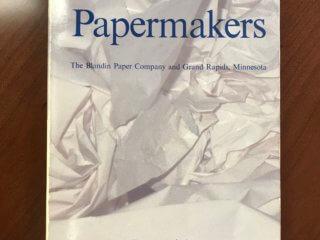 Image: CK by car talking to man in overalls log pile in bkgd 1950.364.10001
Image: CK by car talking to man in overalls log pile in bkgd 1950.364.10001
Our History
Charles K. Blandin established the Blandin Foundation in 1941 to aid and promote Grand Rapids and the surrounding area. In designing the Foundation, Mr. Blandin emphasized flexibility to ensure it could adapt to changing times with an underlying philosophy that its work should lead to the “betterment of mankind.”
Since the sale of the Blandin Paper Company in 1977, nearly 50 years ago, the financial resources of the Foundation have expanded dramatically, as has its area of service. Once linked, the two are now distinctly separate organizations; the Foundation is private and independent of the paper mill, which is currently owned by UPM, based in Finland.
The Blandin Foundation addresses issues to enhance the economic viability of rural communities and the well-being of residents. The Foundation’s management and Board of Trustees work diligently to ensure that Mr. Blandin’s legacy is served through wise investment and progressive leadership programs, meaningful public policy engagement, and grant making.
Reflecting the significant growth from his original endowment over decades, the Blandin Foundation today is focused to connect, fund and advocate for ideas and people to inspire resourcefulness and move rural places forward. The Foundation works toward rural Minnesota places that welcome diversity, address injustice, and embrace change to create a sustainable and equitable future.
The Foundation’s local giving area encompasses Itasca County communities, including Bigfork, Blackduck, Bovey, Calumet, Coleraine, Deer River, Grand Rapids, Hill City, Keewatin, Marble, Nashwauk, Northome and Taconite.
However, the legacy of Mr. Blandin’s endowment truly shines when paired with the passion of individuals within these communities. For this reason, the thousands of rural Minnesota volunteers, social service professionals, business people, public officials, emerging leaders, families, educators, peers, seasoned and new voices, and others also represent the communities we serve.

